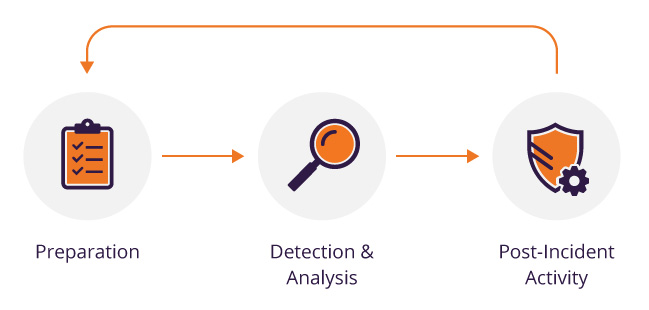When a business faces a cybersecurity breach or ransomware attack, fast and strategic responses are paramount to mitigate damage, restore operations, and fortify against future incidents. This comprehensive guide outlines essential steps and best practices, ensuring businesses can navigate through the crisis effectively.
Containment Strategies
Assessment and Impact Analysis
Isolating affected systems is the first line of defense against a cybersecurity breach. This step involves several critical actions:
- Disconnecting from the Internet: To prevent the attacker from accessing the system remotely and to halt the spread of malware.
- Disabling Wireless Functionalities: This includes Wi-Fi, Bluetooth, and any other wireless connections to prevent lateral movements of the threat within the network.
- Segregating Compromised Network Segments: Physically or logically isolating affected areas from the rest of the network to contain the breach and facilitate targeted cleanup.
- Disabling Affected User Accounts: Quickly identify and disable user accounts that are compromised or used in the breach. This can prevent further unauthorized access and mitigate the risk of lateral movement within the network.
- Activation of Geo-Blocking: If the attack is identified as coming from specific geographic locations, implementing geo-blocking can prevent further malicious traffic from these areas.
- Application of Emergency Patches: If the breach exploits known vulnerabilities for which patches are available, apply these patches immediately to all affected systems to prevent further exploitation.
- Temporary Suspension of Non-Essential Services: Evaluate the services running on the network and temporarily suspend those not critical to business operations. This can reduce the attack surface and help focus defense efforts on essential services.
These measures help to limit the damage by keeping the breach from spreading and providing a secure environment to assess and remediate the situation.
Understanding the extent of the breach is crucial for effective remediation. This involves:
- Identification of Breach: Determining that an unauthorized access event has occurred, identifying the source of the breach, and the method used by attackers (e.g., phishing, malware, exploit of a vulnerability).
- Scope Determination: Identifying which systems, networks, and data were potentially accessed or compromised. This may include reviewing logs, monitoring network traffic, and analyzing the attackers’ movement within the system.
- Data Classification: Assessing the types of data that have been compromised, such as personal identifiable information (PII), financial records, intellectual property, or sensitive corporate data, and classifying them according to their sensitivity and the potential impact of their exposure.
- Stakeholder Identification: Identifying internal and external stakeholders who may be affected by the breach, including employees, customers, partners, and regulatory bodies.
This step is foundational for developing an informed response strategy that addresses all aspects of the breach.
Engagement with Cybersecurity Experts
For organizations lacking in-house expertise to manage severe cybersecurity incidents, engaging with external resources and specialists can be crucial for effective response and recovery.
- Industry-Specific Knowledge: External IRTs often have experience across various sectors, allowing them to apply industry-specific insights to the incident response process. This is particularly valuable in highly regulated industries like finance, healthcare, and energy.
- Advanced Technical Expertise: These teams consist of professionals with deep technical expertise in areas such as digital forensics, malware analysis, network security, and cybersecurity law. Their broad skill set ensures a comprehensive approach to incident response.
- Rapid Deployment: External IRTs can be mobilized quickly, providing an immediate response to incidents. This rapid deployment is crucial in mitigating the impact of a breach by reducing the time attackers have to cause damage.
- Scalability: They offer the flexibility to scale their response based on the severity and complexity of the breach. Whether it’s a targeted attack on a specific system or a widespread compromise, the team can allocate resources accordingly.
- Incident Analysis and Containment: The first step involves analyzing the breach to understand its scope and contain it. This includes identifying the attack vectors, affected systems, and data compromised, followed by implementing measures to stop further unauthorized access.
- Eradication and Recovery: After containment, the team works to eradicate any threats from the organization’s systems and facilitate the recovery of affected services. This may involve cleaning infected systems, patching vulnerabilities, and restoring data from backups.
- Post-Incident Analysis and Recommendations: Following the response, the team conducts a thorough review of the incident, the response effectiveness, and the lessons learned. They provide recommendations for strengthening the organization’s cybersecurity posture to prevent future incidents.
Leveraging external expertise is crucial for organizations to navigate the complex landscape of cybersecurity incident response.
Legal and Regulatory Compliance
Immediate legal consultation is necessary to navigate the aftermath of a breach:
- Cyber Law Specialists: Advising on legal obligations, including breach notifications to regulatory authorities and affected individuals.
- Understanding Data Protection Laws: Compliance with regulations such as GDPR, CCPA, or other relevant laws is critical to avoid fines and legal repercussions.
This step ensures the organization’s response aligns with legal requirements and best practices in cybersecurity.
Developing a Communication Strategy
Effective communication is key to managing the aftermath of a breach:
- Internal Communication: Keeping employees informed about the breach, its impacts, and their roles in mitigation efforts.
- External Communication: Crafting messages for customers, partners, and the public that are transparent yet mindful of legal and investigative concerns.
- Media Relations: Managing the narrative in the media to maintain trust and reputation.
A well-crafted communication strategy ensures that all stakeholders are informed and engaged appropriately during the response process.
Recovery and Restoration Post-Breach

Recovery and Restoration Post-Breach involves a series of strategic steps taken after a security incident to ensure that a system not only returns to its normal state but also gains enhanced protection against future threats. Here’s a more detailed look at the components you mentioned:
Eradication and Recovery Efforts
- Identification and Removal of Threats: The first step involves thoroughly scanning the system to identify all traces of the malicious entities or unauthorized accesses. This might involve forensic analysis to understand how the breach occurred and to ensure that every trace of the malicious actor is identified and removed.
- Expert Assistance: Employing cybersecurity experts or incident response teams who specialize in dealing with breaches can significantly improve the effectiveness and efficiency of the eradication process. These professionals can also offer insights into the nature of the attack and suggest improvements to prevent future incidents.
- Restoration of Data: Once the system is deemed clean, the next step is to restore data from backups. It’s crucial that the backups themselves are clean and were not compromised during the breach. This step often involves restoring critical data first to ensure minimal disruption to business operations.
- Security Assurance: Before fully returning to operational status, a thorough security check is conducted to ensure that the system is not only clean but also more secure than before. This might include penetration testing and vulnerability assessments.
Continuous System Monitoring
- Implementation of Monitoring Tools: Utilize advanced monitoring tools such as SIEM and MDR services that can continuously scan the system for any unusual activities or potential security threats. This involves both automated systems and possibly a dedicated cybersecurity team to analyze and respond to alerts.
- Anomaly Detection: Setting up anomaly detection systems can help identify unusual patterns that may indicate a breach or an attempt. This could include an unusually high amount of data transfer or repeated login failures from a particular source.
- Quick Response: The goal of continuous monitoring is not just detection but also swift response. Establishing protocols for immediate action when a potential threat is detected can greatly minimize the impact of any breach.
- Feedback Loop: Continuous improvement of monitoring based on the incidents and threats detected. Use every incident as a learning opportunity to tighten security measures and refine monitoring criteria.
Recovery and restoration post-breach are critical to ensuring the security and integrity of systems. By carefully eradicating threats, restoring systems, patching vulnerabilities, and adopting continuous monitoring, organizations can not only recover from breaches but also significantly enhance their resilience against future cyber threats.
Post-Incident Actions and Enhancements

The post-incident phase is crucial in managing the aftermath of a cybersecurity breach and strengthening future defenses. Let’s delve into the components you’ve outlined, offering a bit more context and detail for each:
Incident Reporting and Analysis
After a security incident, it’s vital to compile a comprehensive report. This document should detail:
- The Incident Timeline: From initial breach detection to response and resolution, documenting each phase helps identify vulnerabilities and response effectiveness.
- Extent of Damage: Assess and record the scope of data loss, system compromise, and operational impact.
- Detection Methods: Evaluate how the breach was detected to refine detection mechanisms for future threats.
- Response Actions: Detail the steps taken to mitigate the incident, including containment and eradication processes.
- Lessons Learned: Analyze what worked, what didn’t, and why. This section is critical for improving future security posture.
Cybersecurity Training for Staff
Employees are often the first line of defense against cyber threats. Regular training should focus on:
- Phishing Recognition: Teach employees how to identify and report suspicious emails.
- Password Security: Encourage the use of strong, unique passwords and the adoption of multi-factor authentication.
- Safe Internet Practices: Educate on the risks of unsafe browsing, downloading, and data sharing practices.
Investment in Cybersecurity Infrastructure
Strengthen your cybersecurity defenses by investing in:
- Advanced Threat Detection: Implement solutions such as XDR and MDR that can identify and mitigate threats in real-time.
- Encryption Technologies: Protect data in transit and at rest to prevent unauthorized access.
- Secure Backup Solutions: Regular, secure backups ensure data recovery in the event of a breach.
- Security Information and Event Management (SIEM): SIEM solutions provide real-time visibility into an organization’s information security systems. They aggregate and analyze log data from various sources, identifying potential security incidents.
- Zero Trust Architecture: The Zero Trust model assumes that threats can originate from anywhere, and thus, nothing should be trusted implicitly.
- Cloud Access Security Brokers (CASB): CASBs provide a security policy enforcement point between cloud service consumers and cloud service providers.
- Identity and Access Management (IAM): IAM systems manage digital identities and their access to various IT resources. They enhance security by ensuring that only authorized individuals can access certain data and applications.
- Data Loss Prevention (DLP): DLP technologies prevent unauthorized access and sharing of sensitive information, ensuring data remains within the corporate network.
- Security Orchestration, Automation, and Response (SOAR): SOAR platforms enable organizations to collect inputs monitored by the security operations team, such as alerts from SIEM systems and other security technologies.
- Vulnerability Management: Vulnerability management involves identifying, classifying, prioritizing, remediating, and mitigating vulnerabilities in software.
- Threat Intelligence Platforms: Threat intelligence platforms gather, analyze, and disseminate information about current and potential attacks that threaten the safety of an organization or its assets.
- Behavioral Analytics: Behavioral analytics tools analyze data to detect anomalies in user behavior that could indicate threats, such as insider threats or compromised accounts.
Policy Review and Updates
Regularly review and update cybersecurity policies to reflect:
- Current Threat Landscape: Adapt policies to counter new and evolving threats.
- Lessons from Recent Incidents: Incorporate insights from past incidents to close security gaps.
- Accessibility and Understanding: Policies should be clear and accessible to all employees, ensuring they understand their role in maintaining security.
Regulatory Compliance and Follow-ups
Compliance with legal and regulatory requirements is non-negotiable. This might involve:
- Notification Requirements: Adhering to laws that mandate timely notification of data breaches to affected parties.
- Ongoing Communication: Keeping stakeholders informed about remediation efforts and future prevention measures.
Engagement with Law Enforcement
In cases of severe breaches or ransomware attacks:
- Collaboration is Key: Law enforcement agencies can offer additional resources for investigation and recovery.
- Perpetrator Tracking: They play a critical role in identifying and pursuing cybercriminals.
Implementing these steps not only aids in effective recovery from incidents but also significantly contributes to a robust cybersecurity posture, safeguarding your organization against future threats. This structured approach ensures both resilience and compliance, protecting your business and stakeholders from the evolving landscape of cyber risks.
Conclusion
In conclusion, navigating the aftermath of a cybersecurity breach or ransomware attack requires a well-orchestrated response strategy that emphasizes quick containment, thorough assessment, and strategic recovery efforts. By adhering to the outlined steps—from engaging cybersecurity experts and complying with legal requirements to implementing robust recovery processes and enhancing future security measures—businesses can mitigate the immediate impact of such incidents and build a stronger, more resilient cybersecurity posture.
Investing in continuous staff training, advanced security technologies, and regular policy reviews is not just about recovery; it’s a proactive stance against the evolving landscape of cyber threats. Ultimately, the ability to respond effectively to cybersecurity incidents not only protects a company’s assets and reputation but also strengthens its long-term viability and trustworthiness in the digital age.
About Purple Shield Security
Purple Shield Security isn’t just another cyber security firm. Think of us as your digital world’s protectors, always ready to keep your business safe from the latest cyber threats. Our team is full of passionate experts who do more than just look after your data and systems; we give you peace of mind. We offer a wide range of services like Managed Cyber Security, Cyber Security Consulting, Cyber Security Risk Analysis, Cyber Defense Services, Cyber Security Incident Response, and vCISO.
Don’t put off making your business safer. Contact us now to see how Purple Shield Security can upgrade your cyber defenses.

